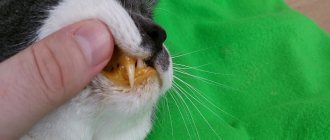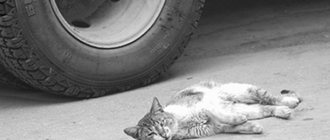Probably, the name of this helminthiasis is familiar to everyone and is associated with something extremely unpleasant. And rightly so. Now let's find out why.
Opisthorchiasis, alas, affects not only people, but also cats.
Moreover, the causative agent of this disease was first discovered in the liver of a cat (in 1884 by the Italian scientist S. Rivolta), and therefore received the name Opisthorchis felineus - cat fluke (due to two suckers - oral and abdominal).
Later it was found that infection of humans and animals (cats, dogs, foxes, otters, etc.) occurs through fish. And for its development, the parasite uses an additional host - a mollusk. Therefore, foci of opisthorchiasis form near freshwater bodies of water. There are many of them in Russia, the northern regions are especially affected.
How are opisthorchises doing?
If you don’t interfere with them, happily ever after (10-25 years).
The eggs of the parasite with the feces of a sick person or animal fall into the water, where they are ingested by mollusks with food. In the intestines of poor snails, opisthorchises undergo the development of larval stages for two months and emerge back into the water in the form of larvae - cercariae. Taking the initiative, nimble cercariae penetrate through the skin of fish into their muscles and subcutaneous tissue. Here they become covered with a membrane (cyst) and after 6 weeks turn into metacercariae. That's it, food is served!
In the picture, instead of a cat, there could be a person, a dog or another animal eating fish. By the way, humans have more opportunities to become involved in the spread of opisthorchiasis than other mammals.
Infection occurs when eating raw or insufficiently processed fish with helminth larvae. Species of carp fish are especially dangerous in this regard.
Metacercariae swallowed together with fish are freed from cysts and through the bile duct enter the bile ducts of the liver, where in 3-4 weeks they reach sexual maturity and begin to lay eggs, which are released with feces. The cycle is complete.
The complete development of opisthorchis from egg to adult stage takes about 4 months. Replenishment of the number of helminths in the body occurs only due to repeated infection(!)
Now we can answer an important question:
Folk remedies
If tablets only cope with cat fluke, then plant-based products help eliminate the disorders resulting from the disease. Herbs produce several effects on the body:
- annoying;
- choleretic;
- laxative;
- anti-inflammatory;
- sedative
To prepare a folk remedy, you will need enough aspen bark to make 20 g of raw material. Next, put it in a thermos and pour 0.5 liters of boiling water. The product must be infused for 12 hours, then strain through cheesecloth. Reception should be carried out in 2-3 tbsp. l. 30-40 minutes before eating. The procedure must be repeated several times a day for 25-30 days.
Celandine decoction
The finished decoction of celandine is also called kvass due to the peculiarities of its preparation. You will need about 100 g of washed and squeezed celandine. It is wrapped in a gauze bag along with a small piece of silicon, which is then placed at the bottom of a 3-liter jar. Next you need to add a glass of sugar and 1 tbsp. l. sour cream and add whey. Kvass is left for 2 weeks in a dark place. You need to drink 0.5 cups several times throughout the day.
You will need 1 drop of tar per 1 glass of milk. This is a daily dosage that needs to be taken at a time. Then, every day you need to add 1 drop to the same amount of milk until their number reaches 20 pieces. Next, you need to do the opposite - reduce by 1 drop every day. The entire course of therapy is 40 days.
Mix equal proportions of tansy and wormwood, then take only 1 tsp. herbal mixture. Pour 250 ml of hot water into it, then simmer over low heat for about 3-5 minutes. The broth should be allowed to cool slightly. The product must be taken warm, 0.5 tbsp. up to 3 times during the day. The course of treatment lasts at least 2 weeks, then take a break of the same duration and repeat the cycle of therapy.
Why is opisthorchiasis dangerous?
Opisthorchises cause harm to the liver, bile ducts and bladder, and pancreas.
- They injure the walls of the bile ducts with their suckers (adults) and chitinous spines (juveniles). Since there are often many parasites and they constantly change places of attachment, the damage can be quite significant.
- The accumulation of helminths and their eggs, mucus, and epithelial cells in the bile ducts prevents the outflow of bile, causing its stagnation, which contributes to the formation of chronic inflammation.
- In the future, even after treatment of opisthorchiasis, liver disease will progress - with the development of inflammation, fibrosis (proliferation and thickening of connective tissues) and ectasia (dilation) of the ducts intensify, which, in turn, favors bacterial infections and inflammation. Vicious circle.
- With opisthorchiasis, as with other invasions, intoxication (poisoning) of the animal is possible. The waste products of parasites can develop allergies.
- The infestation can last for several years. A weakened cat's body becomes easily susceptible to various diseases.
- As a result of prolonged helminthiasis, the animal may die due to significant damage to the liver and bile ducts or secondary diseases.
The most serious consequences of opisthorchiasis are bile peritonitis, cirrhosis or liver cancer, and severe pathologies of the pancreas.
Symptoms
There are several forms of the disease. And in different cases, the symptoms of opisthorchiasis in cats are different. In the latent form, which is often recorded in those regions where most animals or people are infected, there is only a slight rise in temperature and eosinophilia (a blood test will “tell” this).
- In the acute form of opisthorchiasis, the cat’s temperature rises to 39, sometimes even higher. And it lasts from a week to 3. In addition to the fever, severe pain is recorded in the hypochondrium (right, because the liver is located there).
- With chronic damage, symptoms of inflammatory processes in the liver and pancreas are observed. A sick animal has pain in the tummy (its upper part, although mainly the right half due to the location of the liver there), and nausea. Since the liver is inflamed (hepatitis has developed), it cannot perform its functions normally.
Therefore, fatty foods are not digested at all; after eating them, the cat may vomit, even with bile. Because of this, there is bitterness in the mouth, you want to drink constantly, but you still feel dry in your mouth. Jaundice may develop in case of severe infestation. Over time, depression appears, up to complete indifference to life.
If there are so many parasites that they already clog the passages in the bile ducts, then not only jaundice develops (the mucous membranes and skin acquire a yellow tint, the sclera of the eye also reacts to bilirubin, of which there is much more than normal in the blood), but also abscesses appear in the liver (purulent encapsulated areas), then necrosis may form (tissues die). And the last thing is bile peritonitis. When it occurs, bile from ruptured ducts spills into the abdominal cavity. Treatment won't help here. Death is painful, slow.
The easiest way to recognize opisthorchiasis is to take a blood test. With a parasitic disease, eosinophils are higher than normal. Often it is the chronic form of opisthorchiasis that is registered.
In addition to the above symptoms, frequent/loose stools, severe gas formation, and heartburn are noted. Appetite almost completely disappears. Sometimes bronchial asthma may develop. Trembling of the eyelids, tongue, limbs may appear, sleep is disturbed (restless, intermittent) - all this indicates damage to the nervous system.
An allergic reaction is also a common sign of opisthorchiasis. A rash appears on the skin - we used to call it urticaria.
Diagnosis of opisthorchiasis
Opisthorchiasis should be distinguished from various liver diseases (cholecystitis, pancreatitis, hepatitis), toxoplasmosis, viral peritonitis, etc., since their symptoms are similar.
When diagnosing opisthorchiasis, the doctor relies on anamnesis - information from the owner (for example, about feeding the pet raw fish), on the result of the examination and clinical signs.
But! The final diagnosis of opisthorchiasis is made after the detection of parasite eggs in the feces of a cat. A single negative result does not mean the absence of invasion; analysis of several samples may be required for reliability.
In extreme cases, opisthorchises are found during autopsy in the liver of a dead animal. As always, an autopsy will reveal...
Prevention of helminthic infestations
To prevent your pet from becoming infected with helminths, control the quality of the products you use for feeding. We strongly do not recommend giving your pet any fish that has not previously undergone heat treatment, as well as stale, low-quality meat products and offal.
Two or three times a year, regardless of whether the cat walks on the street or does not leave the house, carry out preventive deworming using complex anthelmintic agents that can be purchased at a veterinary pharmacy or veterinary clinic. If you are unsure which drug to give your pet, consult your veterinarian.
Opisthorchiasis in cats is a rather serious disease, which is most often recorded due to eating raw fish. Some pet owners believe that feeding their pets raw fish is very healthy. On the one hand, thermally untreated fish is rich in vitamins and minerals, the same phosphorus necessary for bones and teeth. But on the other hand, raw meat is always a risk of contracting a parasitic or even infectious disease. Today we’ll talk about such an invasion as opisthorchiasis in cats.
Treatment of opisthorchiasis
Opisthorchises are long-lived parasites. The long-term and chronic nature of opisthorchiasis is due to their long life span, as well as the ease of new infections.
Opisthorchiasis is treated by a veterinarian. It largely depends on the degree of damage to the body, the cat’s immune system, and the duration of the disease.
- First, complex symptomatic therapy is prescribed to stabilize the general condition of the animal: relieving the allergic reaction and intoxication, clearing the intestines of blockage (cleansing enemas, antiemetic drugs), prescribing veterinary diets (liver restoration), replenishing fluid in case of dehydration (droppers), vitamin therapy, the use of anti-inflammatory drugs ( including antibiotics), choleretic agents and hepatoprotectors to restore normal bile flow, etc. The preparatory course can be long - up to 2-3 weeks.
- The second stage is anthelmintic therapy using the most effective broad-spectrum agents (Praziquantel). Since the side effects of deworming can be serious, it is best done under the supervision of a doctor in a hospital.
- The third stage of treatment is rehabilitation (restoration of all functions of damaged organs (hepatoprotectors, choleretic agents, diet, etc.))
Thank you for watching!
If you liked the video, share it with your friends:
Pathogen development cycle
The cycle is only at first glance complicated. And this is only because it has two intermediate hosts: a snail and a fish. It all starts with the fact that helminth eggs, which are excreted in feces, must get into the water. Without water, the development cycle will not work. In the water, the eggs are swallowed by snails, in which they develop and reproduce. This stage is called cercariae. From the snail, it again enters the water, and then enters the body of fish (mostly one of the carp family).
For the next stage, the raw fish must be eaten by a person or another predatory mammal (dog, cat, fox or other fur-bearing animals). It is in their body that the helminth “grows up.” In the stomach, the metacercaria capsule dissolves, and from the duodenum the larvae penetrate into the gallbladder, from which they already penetrate into the ducts. Typically, it takes about a month before individuals begin to reproduce inside the host organism. Next, the already sick pet (or a person) releases eggs into the external environment with feces, which can infect other susceptible predators.
Causes
Opisthorchiasis develops when an animal is infected with a cat fluke. This is a flatworm fluke that settles in the bile ducts. The parasite is no more than 12 millimeters long and 2 millimeters wide. There are two suction cups on its body: on the head and on the stomach. Their average diameter is 0.25 millimeters.
The worm is a hermaphrodite and has both male and female reproductive organs. Cat fluke eggs are yellow in color.
The embryo of the parasite is called a miracida. It is found in the egg and enters the environment along with the “host’s” feces. Further development is possible if the egg falls into river or lake water.
Worm eggs that fall into the water become food for shellfish. In the snail's body, the embryo develops into a larva (cercaria) within two months. She is able to live in water, where she finds a new host - fish. Through the skin it enters her muscles, where it continues its development. After six weeks, the larva develops into a metacercaria.
The animal eats the infected fish, after which the metacercaria begins to develop in its body, settling in the bile duct. After a month, the parasite reaches sexual maturity and begins to lay eggs.
source
Contraindications to rhinoscopy in cats
Rhinoscopy has a number of contraindications, including:
- severe nosebleeds;
- chronic pathologies of the cardiovascular system;
- intolerance, impossibility of putting an animal under anesthesia (age);
- injured ENT organs;
- pregnancy, lactation;
- severe pain in the sinuses.











